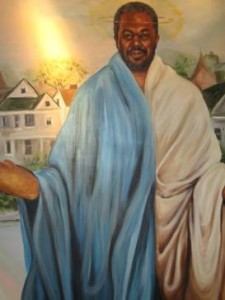
Saint Benedict the African
Image: Fr. Michaelraj Selvam
(Franciscan Media) Benedict was born to parents that were slaves and were brought from African to Italy Messina and then freed.
At the age of eighteen, Benedict worked on a farm and soon saved enough money to purchase a pair of oxen and was very proud of those animals. Later, Benedict would sell what little he had and gave it to the poor and he would subsequently join a group of Hermits around Palermo, eventually he was recognized as their leader–because these Hermits followed the Rule of St. Francis Pope Pius IV Ordered them to join the First Order. Benedict held important posts in the Franciscan Order and gracefully adjusted to other work when his terms of office were up.
Benedict served as Novice Master and then Guardian of the Friars in Palermo, positions rarely held in those day by a Brother, in-fact, Benedict was forced to accept his election as Guardian, when he corrected the Friars, he did so with humility and charity–When his term ended, he happily returned to his duties in the Friary kitchen.
Once Benedict corrected a Novice and assigned him a penance, only later to learn the Novice was not guilty–Benedict immediately knelt down before the Novice and asked his pardon.
In his life, Benedict was never possessive of the few things he used, he never referred to them as ‘mine’ but always called them ‘ours’ — Benedict’s gifts of prayer and guidance, earned him throughout Sicily a reputation of holiness.
Following the example of St. Francis, Benedict kept seven 40 day fasts throughout the year, he also spent much time in prayer only sleeping a few hours each night.
After Benedict died in 1589 King Phillip III of Spain paid for a special tomb for this simple holy Friar, he was subsequently Beatified by Pope Benedict XIV in 1743 and Canonized by Pope Pius VIII in 1807 and is honored as the Patron Saint of African-Americans and African Missions.
More here from Catholic Saint’s Info